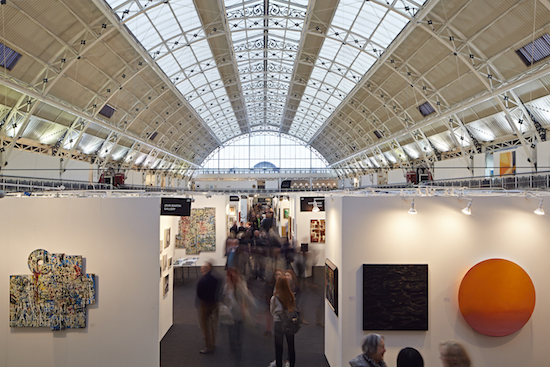“I was priced out of East London and moved to Peckham. Now I’m just about managing to hang on in the South-East.” Emma Hart’s situation may sound familiar, a predictable complaint from a young, London-based artist. Only Hart is a success story. Her works have been shown at Camden Art Centre, the Whitechapel Gallery and the Folkestone and Whitstable Biennials. Last year she won the prestigious Paul Hamlyn Award. And that’s on top of her other job teaching at Central Saint Martins. “My public profile,” she admits, “does not replicate itself in my financial profile.”
If the average wage of a working artist is just ten grand a year and the average rent of a one-bed flat, even in Zone 3 or 4 districts like Tooting, Finchley, and Leytonstone is around a grand a month, what hope for artists without some other source of support? And what does that do to the diversity of voices being represented by the city’s cultural production?
I’m at the London Art Fair for a talk called Artist Studios in London: Keeping creativity in the capital. After Off-Centre: Can Artists Still Afford to Live in London? at Frieze London last October, it’s the second panel discussion on the subject to be held at a major art fair in the capital within a single season. So that’s at least some evidence of a growing awareness in the art world of a serious problem. It’s also clear that the irony of hosting a talk about gentrification and rising rents at an art fair is still lost on practically everyone. With the possible exception, that is, of Emma Hart. “Obviously, we are in an art fair…” she sighs exasperatedly at one point.
Hart’s own work tends to combine video and sculpture into offbeat, irrepressible assemblages. Her interventions into this afternoon’s discussion, likewise. She will burst in with derailing statements prefaced with a “I just want to say this while I’ve got the mic…” and followed by a nervous look from side to side, more like someone who had invaded the stage than been invited to contribute to it. But there is in her conduct something that demands to make its point, directly and forthrightly, interrupting the smooth complacency of the prevailing discourse. Which is perhaps exactly what art should do. And exactly what it risks losing if it becomes a career accessible only to the well-off or the part-time.
Asked what politics can do to restrain the more rapacious practices of developers (and privilege more responsible ones), Hart’s fellow panelist, and Boris Johnson’s Senior Cultural Strategy Officer on the Greater London Authority, Kirsten Dunne points out that in 2022, London will need 1.5 million more homes, 600 more schools and colleges, a 50% increase in transport capacity. In that context, she demands, “what are the reasons to foreground one group of people over another?” But this question frames the issue in a way that is misleading to the point of obfuscatory.
The fact is that throughout the seven and a half years of his administration, Boris Johnson, in his role as Mayor of London, has consistently foregrounded the concerns one group of people over another. But his favoured subjects are neither struggling artists nor underprivileged families and individuals struggling for housing and school places, but super-rich financiers and oligarchs, buy-to-let landlords, and other parties for whom London property represents an investment opportunity more than a place to live. He has presided over the deliberate inflation of a city-wide property bubble against the interests of the majority of his constituents because it suits the interests of his property-owning voter base.
To blame that on artists, as Dunne is implicitly doing by setting their interests up in opposition to those of other citizens, contributing to a narrative that gentrification is driven by culture and not economics, is obscene – especially from someone whose job would appear to be representing culture and the interests of artists before the Greater London Authority.
Hart, the only artist on the panel, is left somewhat bewildered at having to assume such responsibility, frustrated at being told, on the one hand, that art brings in so many pounds per head for the economy while at the same time disrupting settled communities. Can’t we talk about art in some other terms than the purely financial? she begs. “We don’t even benefit from the value we create … I can’t afford the rents that I – apparently – have helped make bigger.”
At either end of the seated panel, Daniel Herrmann, from the Whitechapel Gallery, and Fabio Altamura, from the artist-run gallery and studio complex, Cubbitt, are keen to highlight the importance of co-operatives and artist-run organisations. These are “extremely important models,” stresses Herrmann. And Altamura agrees that “the co-operative model is something that needs to be looked at in terms of the future of this issue.” Not only this issue, but potentially a whole range of issues facing the capital and the country in general. It may be that through an examination of the way artists’ coops and other forms of grassroots, self-organising movements operate, we can begin to find possible solutions to a whole range of contemporary problems.
But this issue is persistently sidelined by Dunne and the panel’s chair, Ben Luke, a critic for mayor Johnson’s pet paper, the Evening Standard. Dunne seems rather more keen to subtly but persistently reframe what an artist is and what artistic activity might be in order to include rather more traditionally entrepreneurial forms of labour like “makers”, “people opening pop-ups”, and “other creatives”. Marketing professionals, temporary cupcake stalls housed in refashioned shipping containers, and 3D printing ‘fablabs’ for the quick production of cheap plastic gewgaws would seem to be Dunne’s idea of London’s bright artistic future.
“This is all sounding incredibly bleak,” Ben Luke giggles as Herrmann spells out the potentially dire consequences for a city increasingly dominated by an atmosphere of precarity with little room for artists.
“It is,” Hart says softly, dead serious.


